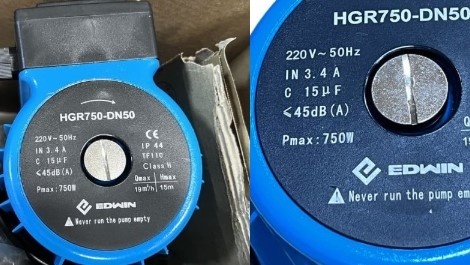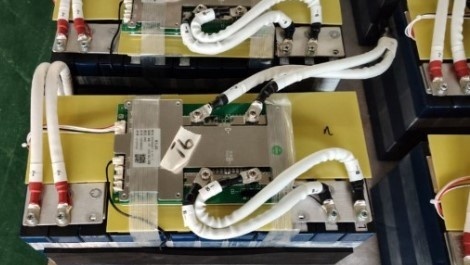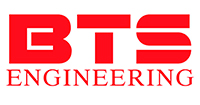November 2024 — Prom-nasos.com.ua
November 29, 2024
Energy-saving pumps with frequency converter

Pumps are indispensable devices in many industries, from heating systems to industrial equipment. Choosing the right pump can significantly improve system efficiency and reduce energy costs. Let's take a look at the features and benefits of these pumps.
Energy-saving pumps are used to optimise energy consumption. They are designed to reduce energy consumption while performing their functions. This is achieved through the use of innovative technologies, such as integrated control systems that adapt the pump to changing conditions. For example, circulation pumps with a frequency converter allow you to adjust the rotor speed, which makes it possible to operate only within the required capacity. This is an ideal solution for heating and water supply systems.
The use of a frequency converter reduces energy consumption, ensures a steady flow and avoids overloading the system. The variable pump speed allows the pump to be precisely adjusted to the needs of the system, which is important for energy conservation.
You can find out more about the circulation pump with frequency converter here.
November 25, 2024
Types of wind turbines

Tulip and H-type wind turbines have different designs and operating principles:
Tulip wind turbines
Design: Vertical wind turbines with a cylindrical shape and curved blades resembling tulip petals.
Advantages:
Effectively operate at low wind speeds, making them ideal for urban and suburban areas.
Reduce noise and vibration due to their shape.
Require less space for installation.
Less hazardous to birds and bats.
Easier to maintain and repair.
H-type wind turbines
Design: Horizontal wind turbines with blades arranged on a horizontal axis.
Advantages:
High efficiency at high wind speeds.
Often used for large wind farms due to their power.
Can generate more energy in stable wind conditions.
Both types have their advantages and disadvantages, and the choice depends on specific conditions and needs.
In addition to the tulip and H-type wind turbines, there are several other main types of wind turbines:
Horizontal wind turbines (HAWT)
Design: The blades are arranged on a horizontal axis.
Advantages:
High efficiency in stable wind conditions.
Often used in large wind farms, both on land and at sea.
Vertical Wind Turbines (VAWT)
Design: Blades are arranged on a vertical axis.
Advantages:
Can operate in variable wind directions.
Easier to maintain as generator and transmission are located closer to the ground.
Other types of wind turbines
Savonius: Vertical wind turbines with two or more curved blades that resemble a drum shape. Used for small installations.
Darrieus: Vertical wind turbines with “C” or “H” shaped blades. They are effective at high wind speeds.
Bladeless wind turbines: Use vibrations to generate power, which reduces noise and vibration.
Each type has its own unique characteristics and is suitable for different conditions and needs.
For a detailed overview of the principle of operation and the choice of the desired model, you can go to the website.
November 22, 2024
Iron-phosphate batteries LiFePO4/LFP

Iron-phosphate batteries, also known as lithium-iron-phosphate batteries (LiFePO4 or LFP) , are a type of lithium-ion battery that has gained popularity due to their safety, durability and stable performance. These batteries differ from other lithium-ion batteries, such as lithium-cobalt-oxide (LiCoO2) batteries, due to their chemical structure, which gives them certain advantages and disadvantages.
Main characteristics of LFP batteries
Chemical composition: Iron phosphate (LiFePO4) is used as the cathode material, while the anode is traditionally made of graphite. The iron phosphate structure provides high resistance to thermal changes, which increases the overall safety of the battery.
Safety: Due to their stable chemical structure, LFP batteries are less prone to overheating and are not prone to thermal runaway, which makes them less vulnerable to fire. This is a significant advantage over other lithium-ion batteries, which can be prone to spontaneous combustion.
Long service life: One of the main advantages is a long cycle life - LFP batteries can withstand 2000-4000 charge-discharge cycles, while retaining most of their capacity. Some high-end models can even exceed 5,000 cycles.
High discharge tolerance: These batteries can be discharged to lower voltage levels without significantly affecting their lifespan. This makes them suitable for applications that require regular deep discharges.
Environmentally friendly: Unlike batteries containing cobalt or nickel, the production of LFP batteries has a lower environmental impact, as iron and phosphate are less toxic and easier to recycle.
Areas of application
LFP batteries are used in a variety of applications, including:
Electric Vehicles: Due to their safety and long cycle life, many electric vehicles use LFP batteries, especially models aimed at the mass market.
Energy Storage Systems: Due to their deep discharge resistance and long life, they are ideal for home and commercial energy storage systems.
Portable Devices and Equipment: They are used in a variety of portable devices and electrical equipment where safety and durability are critical factors.
To learn more about how it works and how to choose the right model, visit the website.
3 posts





























































































































